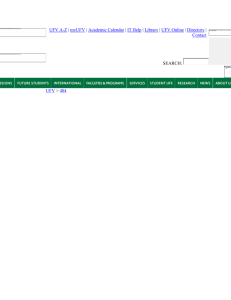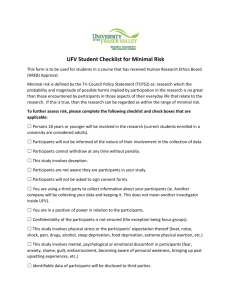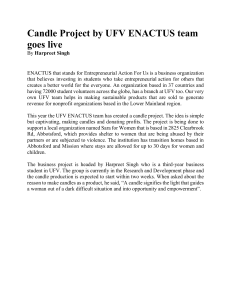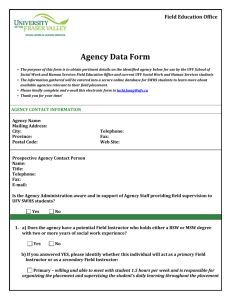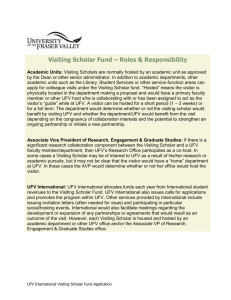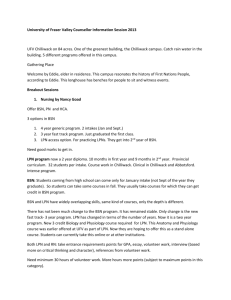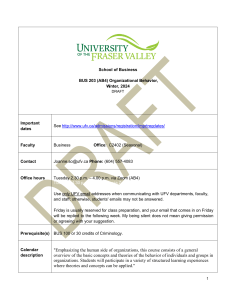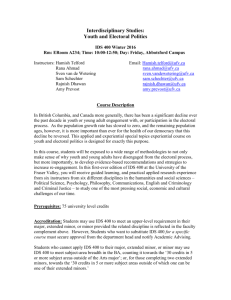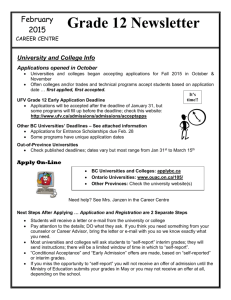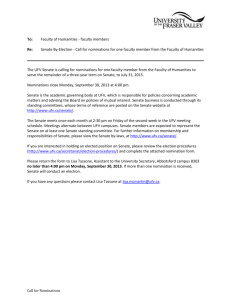Concept Paper Guidelines and Template
advertisement
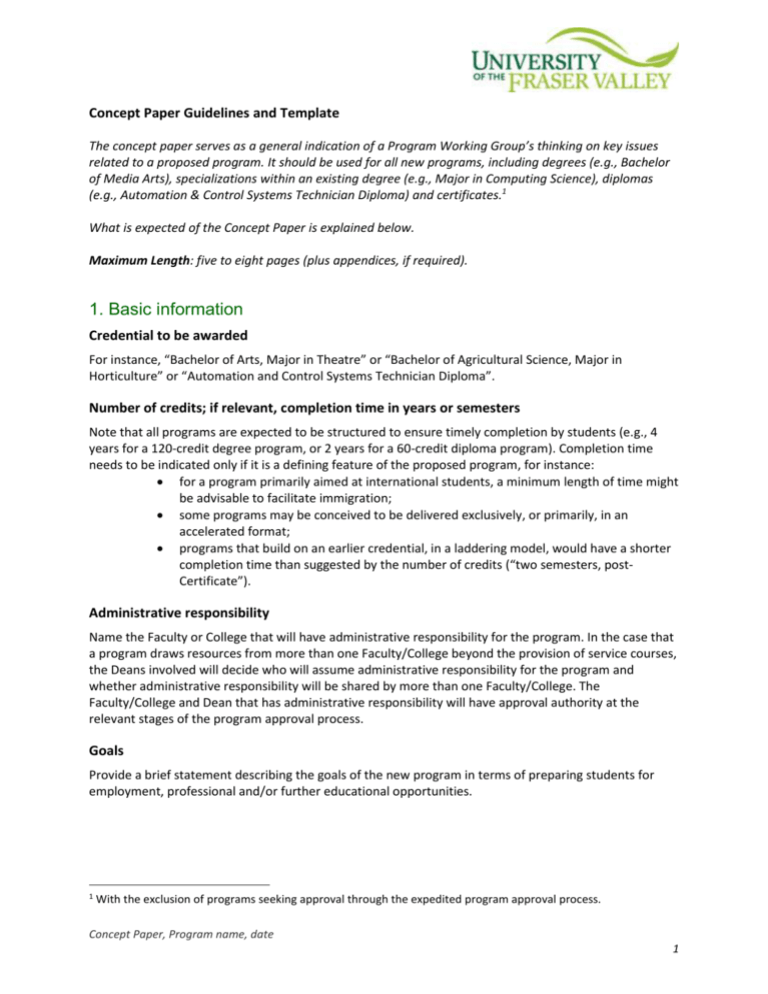
Concept Paper Guidelines and Template The concept paper serves as a general indication of a Program Working Group’s thinking on key issues related to a proposed program. It should be used for all new programs, including degrees (e.g., Bachelor of Media Arts), specializations within an existing degree (e.g., Major in Computing Science), diplomas (e.g., Automation & Control Systems Technician Diploma) and certificates.1 What is expected of the Concept Paper is explained below. Maximum Length: five to eight pages (plus appendices, if required). 1. Basic information Credential to be awarded For instance, “Bachelor of Arts, Major in Theatre” or “Bachelor of Agricultural Science, Major in Horticulture” or “Automation and Control Systems Technician Diploma”. Number of credits; if relevant, completion time in years or semesters Note that all programs are expected to be structured to ensure timely completion by students (e.g., 4 years for a 120-credit degree program, or 2 years for a 60-credit diploma program). Completion time needs to be indicated only if it is a defining feature of the proposed program, for instance: for a program primarily aimed at international students, a minimum length of time might be advisable to facilitate immigration; some programs may be conceived to be delivered exclusively, or primarily, in an accelerated format; programs that build on an earlier credential, in a laddering model, would have a shorter completion time than suggested by the number of credits (“two semesters, postCertificate”). Administrative responsibility Name the Faculty or College that will have administrative responsibility for the program. In the case that a program draws resources from more than one Faculty/College beyond the provision of service courses, the Deans involved will decide who will assume administrative responsibility for the program and whether administrative responsibility will be shared by more than one Faculty/College. The Faculty/College and Dean that has administrative responsibility will have approval authority at the relevant stages of the program approval process. Goals Provide a brief statement describing the goals of the new program in terms of preparing students for employment, professional and/or further educational opportunities. 1 With the exclusion of programs seeking approval through the expedited program approval process. Concept Paper, Program name, date 1 2. Alignment with institutional priorities and existing programming Program learning outcomes (and alignment with ILOs) Even though the learning outcomes presented in the concept paper are likely to be refined as the curriculum structure and content take shape, they should inform the design of a program at the outset. Given the employment, professional, educational goals to be met by the program, what skills, knowledge, and attributes will graduates of this program possess upon completion of the program? (Phrase your program outcomes as “Upon completion of this program, graduates will be able to: …”). You are also asked to articulate how the program outcomes align with UFV’s Institutional Learning Outcomes since the ILOs reflect essential skills and knowledge that every graduate should acquire at UFV. Contribution to UFV’s mandate and strategic priorities Consult UFV’s key planning documents (Strategic Directions, current Education Plan Update, and Strategic Enrolment Management Plan--all available on the UFV Senate website) and explain which institutional priority/ies your program will support. Also consider and discuss how the program will employ high-impact practices and incorporate interdisciplinary opportunities. Related programs in the institution or other British Columbia post-secondary institutions Indicate rationale for duplication, if any. Explain what differentiates this program from similar programs. Is this a program that is completely new to UFV, or does it build on, or complement, existing programs? If relevant, explain its relationship to existing programs and provide a justification if it duplicates, significantly overlaps, or is likely to replace an existing program over time. Also provide a list of similar programs at other institutions in British Columbia and, if duplication exists, explain how the proposed program will be competitive in the BC post-secondary environment. Why should students take this program at UFV rather than at another institution? 3. Audience, demand and capacity Audience What type or group of students will your program attract? For instance, high-school graduates; midcareer professionals; students laddering from a previous program; international students; students currently attracted to a cognate program. Student demand Provide evidence of student demand and anticipated annual enrolments for the program. (If anticipating attracting international students, please consult with leadership at UFV International, and provide evidence of consultation.) Employment for graduates and/or opportunities for further study What will graduates of this program do? What areas/sectors of employment and/or occupational categories will the skills and learning acquired in this program prepare them for? What are the current Concept Paper, Program name, date 2 and anticipated labour market conditions and career outlooks in the relevant sectors and occupations? What further educational opportunities will the program prepare students for? Existing capacity and/or possible resource needs Will this program draw on existing resources and/or is it likely to need additional resources? Consider faculty and staff, labs, space, technical support, etc. A detailed budget analysis will be produced in the program development stage; but you and your Dean should have a general idea that the proposed program is financially viable and sustainable. 4. Program working group membership List the members of the PWG and the reasons for their selection. Include brief biographies and credentials of PWG members. The PWG should consist of a minimum of three faculty members with teaching or research expertise in the subject area. Normally, PWG members should be permanent UFV faculty members. If a new program is entirely discipline-based, at least one additional member from another discipline with teaching or research expertise in the subject area or related area should be included. Note that only approved PWGs should develop and present Concept Papers for inclusion in the Education Plan. 5. Consultation process Please indicate what consultation has taken place already about the proposed program and/or what consultation is anticipated later in the program development stage (this may include consultation with the community or prospective employers through an Advisory Committee; on indigenizing; with other academic units at UFV; with other institutions who offer a similar or related program). 6. Anticipated start date and timetable for development, review/approval, and implementation By requesting inclusion of a concept paper in the Education Plan, you are notifying the institution of your commitment to develop the proposed program, and to do so in a timely fashion in order to allow for budget and enrolment planning. The Program Development Office will work with the Dean and the Program Working Group to set a realistic date when the program will be launched. This will include a reasonable timetable for development of the full program proposal, internal and external review and approval, and implementation. The latter should take into account, for instance, inclusion in the Academic Calendar after approval, timetabling of courses needed for the program, advertising and marketing, and recruitment cycle for International students (October to May). Significant delays in meeting key landmarks (for instance, entering the review and approval stage of the process) could lead to being asked to submit a revised timetable or withdraw the program from the planning process. Education Plan updates will include status reports on programs in development. Concept Paper, Program name, date 3
